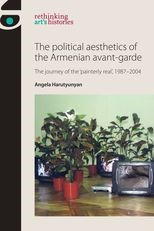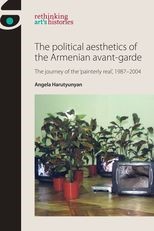The Political Aesthetics of the Armenian Avant-Garde: The Journey of the 'Painterly Real', 1987-2004
The Political Aesthetics of the Armenian Avant-Garde: The Journey of the 'Painterly Real', 1987-2004
Cite
Abstract
The book addresses late-Soviet and post-Soviet art in Armenia in the context of turbulent social, political and cultural transformations in the late 1980s, throughout the 1990s and in early 2000s through the aesthetic figure of the ‘painterly real’ and its conceptual transformations. It explores the emergence of ‘contemporary art’ in Armenia from within and in opposition to the practices, aesthetics and institutions of Socialist Realism and National Modernism. The book presents the argument that avant-garde art best captures the historical and social contradictions of the period of the so-called ‘transition,’ especially if one considers ‘transition’ from the perspective of the former Soviet republics that have been consistently marginalized in Russian- and East European-dominated post-Socialist studies. Throughout the two decades that encompass the chronological scope of this work, contemporary art has encapsulated the difficult dilemmas of autonomy and social participation, innovation and tradition, progressive political ethos and national identification, the problematic of communication with the world outside of Armenia’s borders, dreams of subjective freedom and the imperative to find an identity in the new circumstances after the collapse of the Soviet Union. This historical study outlines the politics (liberal democracy), aesthetics (autonomous art secured by the gesture of the individual artist), and ethics (ideals of absolute freedom and radical individualism) of contemporary art in Armenia. Through the historical investigation, a theory of post-Soviet art historiography is developed, one that is based on a dialectic of rupture and continuity in relation to the Soviet past. As the first English-language study on contemporary art in Armenia, the book is of prime interest for artists, scholars, curators and critics interested in post-Soviet art and culture and in global art historiography.
-
Front Matter
-
Introduction
-
1
Between the ideal and a hard place: the conceptual horizons of the avant-garde in Armenia
-
2
The ‘painterly real’ of contemporary art: resurrected ghosts, living heroes and saintly saviours on the 3rd Floor, 1987–94
-
3
Suspending the ‘painterly real’: ACT’s procedures of ‘pure creation’, 1993–96
-
4
The revenge of the ‘painterly real’: national post-conceptualism, 1995–98
-
5
The reign of the ‘painterly real’ and the politics of crisis, 1999–2004
-
End Matter
Sign in
Personal account
- Sign in with email/username & password
- Get email alerts
- Save searches
- Purchase content
- Activate your purchase/trial code
Institutional access
-
Sign in through your institution
- Sign in with a library card Sign in with username/password Recommend to your librarian
Institutional account management
Sign in as administratorPurchase
Our books are available by subscription or purchase to libraries and institutions.
Purchasing information| Month: | Total Views: |
|---|---|
| January 2024 | 2 |
| April 2024 | 1 |
| April 2024 | 2 |




Get help with access
Institutional access
Access to content on Oxford Academic is often provided through institutional subscriptions and purchases. If you are a member of an institution with an active account, you may be able to access content in one of the following ways:
IP based access
Typically, access is provided across an institutional network to a range of IP addresses. This authentication occurs automatically, and it is not possible to sign out of an IP authenticated account.
Sign in through your institution
Choose this option to get remote access when outside your institution. Shibboleth/Open Athens technology is used to provide single sign-on between your institution’s website and Oxford Academic.
If your institution is not listed or you cannot sign in to your institution’s website, please contact your librarian or administrator.
Sign in with a library card
Enter your library card number to sign in. If you cannot sign in, please contact your librarian.
Society Members
Society member access to a journal is achieved in one of the following ways:
Sign in through society site
Many societies offer single sign-on between the society website and Oxford Academic. If you see ‘Sign in through society site’ in the sign in pane within a journal:
If you do not have a society account or have forgotten your username or password, please contact your society.
Sign in using a personal account
Some societies use Oxford Academic personal accounts to provide access to their members. See below.
Personal account
A personal account can be used to get email alerts, save searches, purchase content, and activate subscriptions.
Some societies use Oxford Academic personal accounts to provide access to their members.
Viewing your signed in accounts
Click the account icon in the top right to:
Signed in but can't access content
Oxford Academic is home to a wide variety of products. The institutional subscription may not cover the content that you are trying to access. If you believe you should have access to that content, please contact your librarian.
Institutional account management
For librarians and administrators, your personal account also provides access to institutional account management. Here you will find options to view and activate subscriptions, manage institutional settings and access options, access usage statistics, and more.